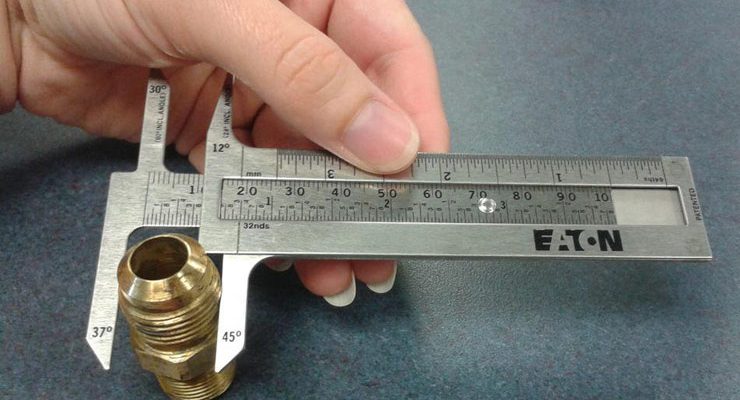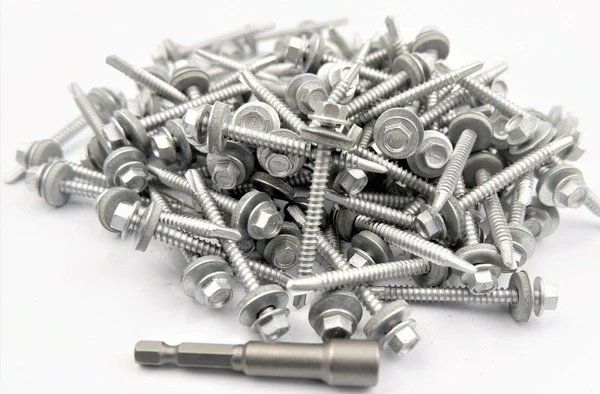
How to identify thread type
To identify thread type, measure the diameter and pitch using a caliper and thread gauge. For example, a 1/4-20 UNC thread has a 1/4-inch diameter with 20 threads per inch. Metric threads like M10×1.5 have a 10 mm diameter and 1.5 mm pitch.
Definite thread series
There are a wide variety of threads that require different thread standards for different scenarios, including inch standard threads (UN), metric threads (ISO), pipe threads (BSP and NPT), and trapezoidal threads (Acme) for special applications.
Metric thread is one of the most widely used thread standards in the world. According to ISO standards, metric threads are measured in millimeters, with common diameters including M8 (8 mm), M10 (10 mm), and M12 (12 mm) with pitches of 1.25 mm, 1.5 mm, and 1.75 mm, respectively. In bicycle maintenance, many parts use M6×1.0 threads, the diameter of the bolt is 6 mm, and the pitch is 1 mm.
British thread (UN) is mainly used in the United States and other British system countries. Inch threads are distinguished by the number of threads per inch (TPI), and common UN series include UNC (Uniform coarse thread) and UNF (uniform Fine thread). A thread of 1/4-20 UNC indicates a thread diameter of 1/4 inch with 20 threads per inch and a pitch of 1.27 mm. Coarse threads are often used to tighten wood and metal in the woodworking and construction industries because their larger pitch provides a stronger fastening force. Fine threads (e.g. 1/4-28 UNF, representing 28 threads per inch with 0.91 mm pitch) are more suitable for applications requiring precision fastening such as aerospace devices.
BSP (British Standard pipe thread) and NPT (American National Pipe Thread) are the most common pipe thread standards. The pitch and diameter of the BSP thread are in imperial units, and the outer diameter of the pipe thread of the 1/2 inch BSP is 21.3 mm, which is commonly used in domestic water pipe systems. The NPT thread is widely used in the US market, and its tapered design provides a better sealing effect. The common 1/2-14 NPT means that the thread has an outer diameter of 1/2 inch, 14 threads per inch, and a pitch of 1.814 mm, which is suitable for gas or liquid high-pressure systems.
In heavy industry, Acme trapezoidal threads are often used for equipment carrying high loads. With a thread Angle of 29 degrees, the trapezoidal thread provides a larger contact area than the common 60 degree thread Angle and is therefore able to withstand greater axial forces. A 2-inch diameter, 5-thread/inch (TPI) Acme thread, for example, has a pitch of 5.08 mm and can support thrust of up to 10,000 pounds of force.

Identification thread form
There are many types of thread, common ones include unified thread (UN), metric thread (ISO), pipe thread (NPT and BSP), and trapezoidal thread (Acme).
There are two main forms of unified thread: unified coarse thread (UNC) and unified fine thread (UNF). Their standard thread Angle is 60 degrees. In the case of a 1/2 inch thread, 1/2-13 UNC means that the thread has a diameter of 12.7 mm with 13 threads per inch. The 1/2-20 UNF means that the thread has 20 threads per inch and a finer pitch for high-precision fastening applications. UNC is often used in general mechanical fasteners, especially in the construction field, such as woodworking screws, steel frame connectors, etc., while UNF is mostly used in high-precision occasions such as aerospace and automotive industries.
Metric thread (ISO) is another thread standard commonly used worldwide. The thread Angle is also 60 degrees, but in millimetres. Common metric thread diameters are M6 (6 mm), M8 (8 mm), and M12 (12 mm), while pitch ranges from 0.75 mm to 2.5 mm. Taking M10×1.5 as an example, it means that the thread diameter is 10 mm and the pitch is 1.5 mm. In modern automotive manufacturing, many bolts use metric thread standards, and M10 bolts typically have a torque range of 40 to 60 nm.
Pipe threads (NPT and BSP) are the two most common forms of thread. NPT (National Pipe Thread, National standard pipe thread) is a cone thread widely used in the United States, the thread Angle is 60 degrees, and its cone design can form a stronger sealing effect when tightened. Common NPT sizes include 1/4-18 NPT, which means that the thread diameter is 6.35 mm, there are 18 threads per inch, and the thread taper is 1:16. This thread is commonly used in high pressure gas and liquid delivery systems and can withstand pressures of up to 5000 PSI, making it suitable for use in the petrochemical industry. The BSP (British Standard Pipe) thread is mainly used in Europe and other British countries. The thread Angle of the BSP thread is 55 degrees, divided into cone and straight two types, the common BSP size is G1/2, the thread outside diameter is 21.3 mm, often used in water pipe systems.
Trapezoidal thread (Acme) is a form of thread designed for high loads. Unlike conventional thread forms, the Acme thread has a thread Angle of 29 degrees, and its square thread can bear greater torque. Acme 1.5-5 indicates a thread diameter of 1.5 inches with 5 threads per inch. This form of thread is commonly used on the screw of machine tools and can withstand thrust of up to 10,000 Newtons, ensuring stable operation of equipment under high loads.

Check thread Angle
The thread Angle refers to the Angle between the thread peaks, and the common thread angles are 60 degrees, 55 degrees and 29 degrees.
The two standard threads, United thread (UN) and Metric thread (ISO), have a thread Angle of 60 degrees, and this 60-degree thread design provides good bearing capacity and self-locking performance in most fasteners. The M10×1.5 metric thread not only has a thread Angle of 60 degrees, but also has a pitch of 1.5 mm, which makes this combination ideal for use in vehicle manufacturing. An automobile engine bolt, for example, can withstand an axial pull of up to 5,000 Newtons when applying 40 to 50 nm of torque using the M10 thread specification.
The NPT Thread (National Pipe Thread) has a thread Angle of 60 degrees, and this tapered thread is designed for fluid and gas delivery in high-pressure systems. In the case of 1/2-14 NPT, the taper of the thread is 1:16, which produces a very strong self-sealing effect when tightened, suitable for high-pressure liquid delivery systems up to 10,000 PSI.
The thread Angle of the BSP (British Standard Pipe) thread is 55 degrees, the thread diameter of the G1/2 BSP is 21.3 mm, and it can withstand 150 PSI. The BSP thread is widely used in the connection of taps, pipe joints and valves, and the 55 degree Angle guarantees good sealing while facilitating the disassembly and maintenance of pipes.
The Acme thread has a thread Angle of 29 degrees, and the Acme 2-4 thread specification indicates a thread diameter of 2 inches and a pitch of 4 threads per inch, which is designed to withstand thrust of up to 15,000 Newtons. This 29 degree thread Angle makes the thread teeth wide and the contact area large, making it ideal for use in screw drives in machine tools.
Find thread mark
Thread marks are engraved on the surface of bolts, nuts, pipe fittings and other fasteners. Through these marks, you can quickly understand the specification, material, strength level and other information of the thread.
The marking for ISO Metric Threads contains the diameter and pitch of the thread, with common marks such as M12×1.5 indicating a nominal diameter of 12 mm and a pitch of 1.5 mm. Many cars use the M12×1.5 thread mark, indicating that the bolt diameter is 12 mm, the pitch is 1.5 mm, this specification of bolts can withstand about 4000-5000 Newtons of tension, ensuring that the wheel can be firmly attached to the axle.
Unified Threads (UN) are marked differently. In the case of 1/2-13 UNC, this mark indicates that the thread diameter is 1/2 inch, the number of threads per inch is 13, and it is a uniform coarse thread (UNC). This type of thread is widely used in construction, industrial equipment and other fields. In steel construction, the use of 1/2-13 UNC bolts can provide a bearing capacity of up to 2,000 pounds.
The marking of Pipe Threads in piping systems is more complex. Taking 1/2-14 NPT as an example, it means that the diameter of the thread is 1/2 inch, there are 14 threads per inch, and it belongs to the United States National Pipe thread (NPT). The 1/2-14 NPT pipe threads used in oil pipelines can withstand pressures up to 5,000 PSI.
Thread markings show not only thread specifications, but also material and strength grade information. The common mark on stainless steel bolts is A2-70, where A2 stands for stainless steel material and 70 indicates that the tensile strength of the bolt is 700 MPa. The life of stainless steel bolts using the A2-70 mark in the salt spray environment can reach more than 10 years, while the life of ordinary steel bolts in the same environment may be less than 2 years.



